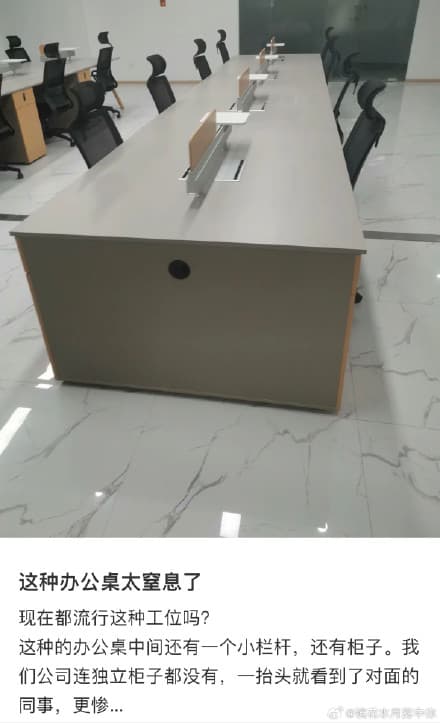Open Office Layout: A Divisive Workspace Trend in China
The Open Office Layout: A Controversial Workspace Trend in China

18 February 2024
In recent times, there has been a growing popularity of open office layouts in China, where employees work in shared, large spaces instead of traditional closed cubicles or individual offices. While some companies have adopted this trend to foster collaboration and creativity, others argue that the lack of privacy and personal space can lead to distractions, increased stress, and a decline in employee productivity.
Recently, Weibo users have been sharing their experiences and opinions on this new office trend, with many expressing frustration and discomfort. One user shared, "I feel suffocated working at open office layouts," while another said, "This type of desk is so suffocating, it would be hell for someone with social anxiety."
Open office plans usually involve long desks, often without any barriers or dividers, making it difficult for employees to focus on their tasks without being distracted by their colleagues' conversations or movements. Some shared pictures of their desks, with one user lamenting, "We don't even have individual cabinets, and when I look up, I see my coworker's face... It's even more depressing."
Several users shared their experiences of working face-to-face with their colleagues, which can lead to awkward situations and accidental kicks. One Weibo user commented, "Imagine how awkward it would be to work face-to-face with someone, and if they have long legs, they might accidentally kick you."
The idea of shared spaces also extends to higher-ranking employees, with many people expressing disbelief that even managers and executives are now sharing desks in open areas. One user asked, "How can managers and executives not have individual offices? I was under the impression that they all had their own spaces."
Some users questioned the true motives behind this open office trend, suggesting that it might be driven more by cost-saving measures rather than genuine concern for employee well-being. One Weibo user commented, "Open office plans are just a way to save on rent – flat management is about control, while the appearance of openness is more about washing each other's mouths in full sight."
In response to these concerns, some companies maintain that the open office layout can actually increase productivity by encouraging teamwork and collaboration. One user shared, "The open office might be cramped, but it forces people to communicate and cooperate more."
Despite these arguments, many Weibo users remain unconvinced by the potential benefits of the open office layout. One user shared, "I just came back from vacation, and it feels like the holidays went by so fast." Another user commented on the lack of privacy and personal space in open offices, stating, "The decor of one's workspace can reveal a lot about their intentions. The fact that these spaces are so congested indicates that the employees are not expected to stay for the long term."
Some users went as far as to suggest that the popularity of open office layouts might not be the result of a conscious decision, but rather a byproduct of the growing number of sales-focused companies in China. One Weibo user commented, "Sales-focused companies usually have employees working at shared desks, whereas functional departments typically have individual desks and computers."
Despite the mixed reactions to this workspace trend, it seems that many Chinese companies are embracing open office layouts, even for higher-ranking employees. Whether this trend will continue to grow or eventually give way to other, more employee-friendly designs remains to be seen.
In the meantime, employees in China will have to adapt to this new reality, navigating the challenges and benefits of working in an open office environment. And as long as the debate over open offices continues to rage on social media, it is clear that this issue will remain a hot topic for some time to come.
Share this article
Related Articles

Mother’s Hand‑Stitched Nike Backpack Goes Viral, Showcasing Love, Craftsmanship and Brand Authenticity in China
By Trending on Weibo
Culture
15 Sept 2025

China’s “National Treasure Highlights” Campaign Turns Heritage Into Global Soft‑Power and Consumer Brand】
By Trending on Weibo
Culture
13 Sept 2025

Mystery Meme: Unraveling China’s “Dissected 14 People, Crumbled by a Letter” Phenomenon】
By Trending on Weibo
Culture
8 Sept 2025

Chinese Netizens Turn Blood Moon Into Viral “Too Abstract” Meme
By Trending on Weibo
Culture
8 Sept 2025

From Song Dynasty Verse to 2024 Drama: The Enduring Echo of “Rain‑Laden Bells” in Chinese Culture
By Trending on Weibo
Culture
8 Sept 2025